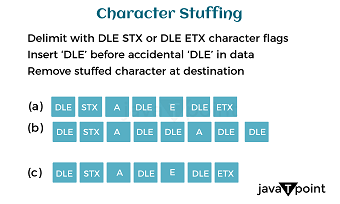Character stuffing program in CCharacter stuffing is a technique used in computer programming to control data transmission between different systems or devices. It involves adding special characters or sequences of characters to the data being transmitted to mark the beginning and end of a data frame. This article will explore character stuffing and how it can be implemented in the C programming language. Character stuffing is commonly used in data communication protocols to ensure the receiving system correctly interprets the transmitted data. It helps frame the data so that the receiver can easily identify the start and end of each data frame. One common use case of character stuffing is serial communication, where data is transmitted one bit at a time over a communication channel. 
Implementing character stuffing in C involves adding special characters or sequences of characters to the original data before transmission and removing them at the receiving end to extract the original data. Look at a simple example of a character stuffing program in C. Example: Output: Original Data: Hello World! Stuffed Data: Hello World! Destuffed Data: Hello World! Explanation: In the above example, we are defining two functions - characterStuffing() and characterDestuffing(). The characterStuffing() function takes the original data and the special characters for start, end, and escape as input and generates the stuffed data by adding escape characters wherever necessary. The characterDestuffing() function takes the stuffed data and removes the escape characters to retrieve the original data. The main() function demonstrates the usage of these two functions. It defines an original data string, and uses the character stuffing () function to generate the stuffed data. After that, it uses the characterDestuffing() function to retrieve the original data from the stuffed data. Character stuffing is a simple yet effective technique to ensure reliable data transmission between systems or devices. It helps in framing the data in a way that can be easily. Here's some more information on character stuffing in C:
In conclusion, character stuffing is a technique used in computer programming to ensure reliable data transmission by adding escape characters to control characters in the data. It is commonly used in communication protocols. It can be implemented in C by adding escape characters before control characters in the original data and removing them at the receiving end. Care should be taken to choose appropriate control and escape characters, and error-checking mechanisms can be implemented to ensure data integrity. Some more examplesHere are a few more examples of character stuffing in C: Start and End Character Stuffing: Let's consider an example where the Start of Frame (SOF) character is '<' and the End of Frame (EOF) character is '>'. In this case, the implementation of character stuffing in C could look like this: Multiple Character Stuffing: In some cases, multiple control characters may need to be stuffed. For example, if we have two control characters, SOF as '<' and a custom control character as '#', the implementation could be as follows: Error Handling: To handle errors in character stuffing, an additional step can be added to check for the escape character in the original data and use a specific escape sequence. For example, if the escape character is '', and the control characters are '<' for SOF and '>' for EOF, then the escape sequences could be '<' for SOF, '>' for EOF, and '\' for the escape character. These are just examples of character stuffing implementation in C and can be further customized based on specific requirements and constraints of the communication protocol being used. It's important to thoroughly understand the specifications and requirements of the protocol before implementing character stuffing to ensure reliable data. SummaryIn summary, character stuffing is a technique used in data communication protocols to ensure the reliable transmission of data. It involves adding special control characters or escape sequences before reserved or control characters in the original data to prevent them from being misinterpreted as control signals. This technique helps avoid data collision or misinterpretation, especially when the reserved or control characters are part of the data being transmitted. |
 For Videos Join Our Youtube Channel: Join Now
For Videos Join Our Youtube Channel: Join Now
Feedback
- Send your Feedback to [email protected]
Help Others, Please Share










